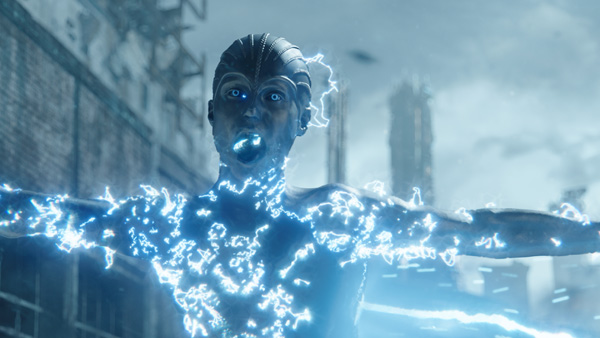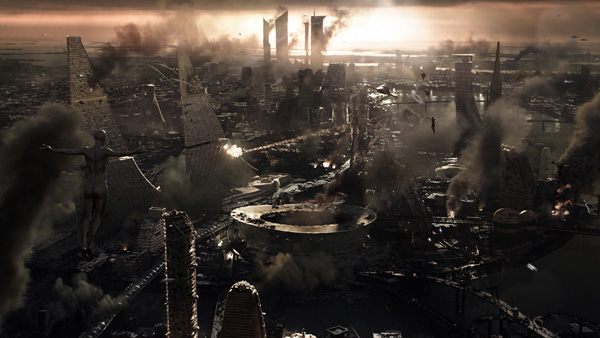
MR. X delivered 476 VFX shots for the recent science fiction series ‘Raised By Wolves’, directed by Ridley Scott and streamed on HBO Max. Working with overall VFX Supervisor Ray McIntyre Jr. and VFX Producer Ruth Hauer during post-production from June 2019 through summer 2020, MR. X divided the work on their shots between the company’s Toronto and Bangalore studios, overseen by their VFX Supervisor Eric Robinson and VFX producer Samantha Banack.
The story is about two androids, Mother and Father, tasked with raising human children on a mysterious, unexplored planet called Kepler-22b after the Earth was destroyed by wars. Their job is to establish an atheist civilisation, but they meet resistance from members of a Mithraic religious mission living within the new colony. As the colony grows, it threatens to be torn apart by religious differences, and the androids learn that controlling the beliefs of humans is treacherous and difficult.
MR. X’s work ranged from creating Mother’s powerful metallic alter ego the Necromancer, building war-torn cities on earth and alien geography, and visualising the deadliest scream.
Visual Language
Eric said that the team at Mr X were well prepared for a project with an otherworldly approach to VFX. “Ridley Scott has his own visual language, and as I am a fan of his films, it was exciting and interesting to dive into that look,” he said. “The white Android blood, dust devils and stark environments were all part of this. We also knew that the DI and colour grade were going to push the shots into a stylised look that wasn’t represented in the dailies or the CDLs that we were working with.
“Ridley prepared his own sketches and storyboards that were simple, but also very clear in describing the framing and scale. The process of taking his sketches from concept to photoreal was fascinating.”
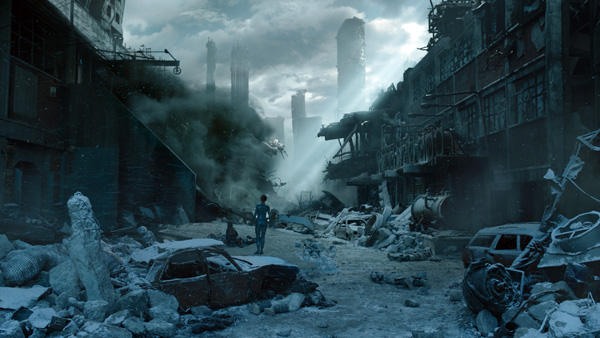

The team at Mr. X were not involved in the shoot that took place in South Africa, standing in for Kepler -22b, but Eric in particular would have loved going to the location. “I had a great experience working there for the shoot of 'Resident Evil: The Final Chapter'. Many team members from that film were also involved in ‘Raised by Wolves’” he said. “Also, while working on ‘Resident Evil’, we had looped in Black Ginger, a great VFX company in Cape Town, to help us with previs and scanning as well as some full shot work. On this project, they worked with us again on previs and scanning the cast.”
Flashbacks
The battles cene shots comprising Mother’s flashbacks of war-torn Boston, a significant location in the story, were of two distinct types. The first were wide aerial establishers, and the second were ground-level scenes. “Production had constructed a wide swath of practical trenches littered with debris covered in snow or ash, and this was the anchor that we built from. We built the environment from concept work, using the real-world geography of Boston for the layout. The 60 to 70 per cent of the environment closest to camera was fully CG, from look development to modelling and texturing through to the render,” said Eric.
“To manage such a massive build, we created a library of futuristic, damaged buildings to seed into our ground-level shots. The very distinctive 'shark-fin' buildings were a key visual element from Ridley’s sketches and as we moved into production on the shots, we learned that a later episode was going to feature a stadium that we would need to incorporate into the cityscape as well. Having so much of the city in full 3D allowed us to accurately layer in these elements, plus flying ships, smoke, fires and explosions.”
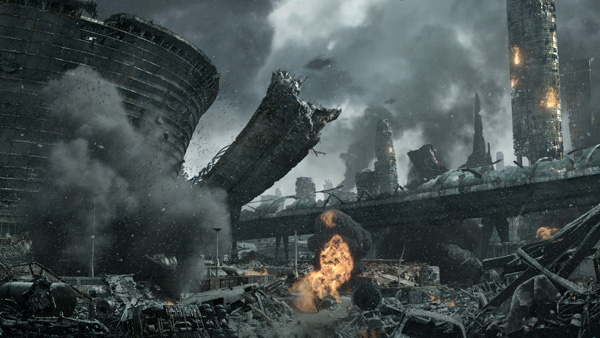
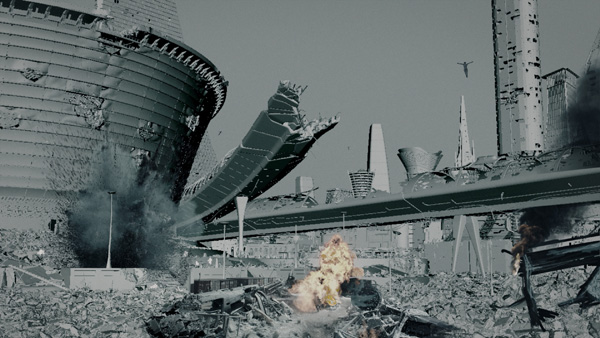
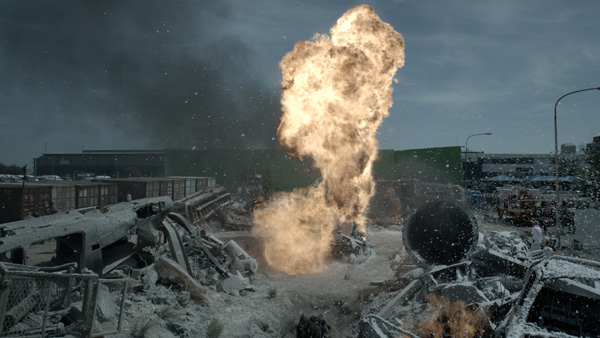
Destruction
As a story point, it was important to show how Earth was becoming uninhabitable in these shots, and that the war had been going on for a long time. Damage to buildings was extensive and varied, still on fire in some places, as well as rusted and stained from long exposure to the elements. The artists had to continue the practical snow and ash from above in the extensions, as well as adding background smoke plumes, explosions and fighting action. Digi-double soldiers were built and animated to create background action and reaction to aerial bombardment.
Mother’s first flashback to war-torn Boston is an important sequence when she dreams of flying as she relearns her powers as the Necromancer, the metallic killer version of Mother. “Another big moment for us was the crash of the Atheist aircraft, of which we created a CG version for the tail end of the flight. A partial build was then constructed on set – with a wire pull rig to position it – that we took over in post to create the final crash.
Alien Geography
A very different environment the team were responsible for was the mountainous desert country on the alien planet. “Production had cleared a wide swath of land to build the practical set, which needed very little augmentation apart from clean-up of modern-day trails and enhancing the background greenery that had been cut in a way that didn’t look natural enough for an unexplored planet,” said Eric.

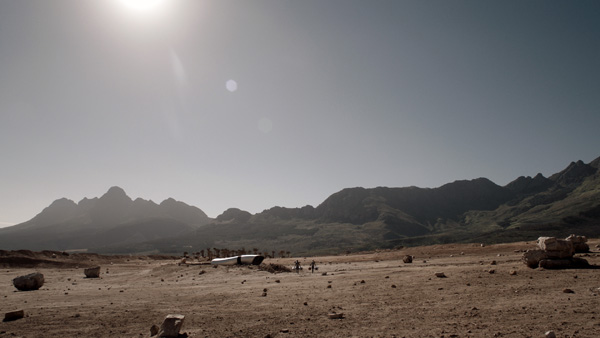
“But the landscape beyond the set was different. The midground hills were in the practical photography from the location, but we created the massive mountain in the background as a very specific piece of geography that Ridley wanted to see in this world. We referred to it as Olympus Mons, inspired by the huge mountain on Mars. It was used as a geographical anchor for the background and formed a focus for the shoot that was unique. The mountain was eventually a shared asset, and it was great to see it in other vendors’ work as an essential part of Ridley’s vision.”
Necromancer
As the central character in the story, Mother in her Necromancer form was one of the most important effects MR. X created and was designed as a transformation. As mentioned, Black Ginger in Cape Town handled the scanning of the actor. This included a FACS scan, allowing them to rig the facial modelling for lip-sync and keep enough control for the Necromancer’s deadly scream attack.
There were two aspects to creating this alter ego and shifting between Mother and the Necromancer – her metallic skin, and her subtly different musculature.
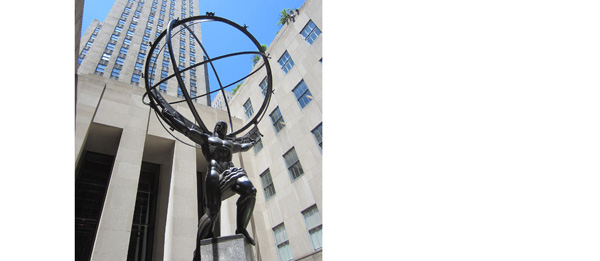
(Image: Another Believer)
In order to create a convincing, metallic look and feel for the character, the team collected photo references of the aged bronzed statue of Atlas at the Rockefeller Centre in New York City. This meant finding and referring to images of the Atlas captured at all times of day and under different lighting conditions, from natural light to flash photography, to make sure the bronze would react to the environment realistically.
Eric remarked on the benefit of having a specific goal for the look of the bronze. “I just wish I had been in NYC to photograph it myself. Daylight vs the flash lighting really drives the look of the statue. We needed the Necromancer to look interesting in a lot of different lighting scenarios, and after a few rounds it felt like we got there.”
Under the Skin
Achieving the musculature of the Necromancer posed a different challenge. The MR. X team based their work on Black Ginger's scan and FACS data of Mother, and had to transform the looks from Mother to the Necromancer and back again multiple times. Therefore, the key proportions of the two needed to match precisely.
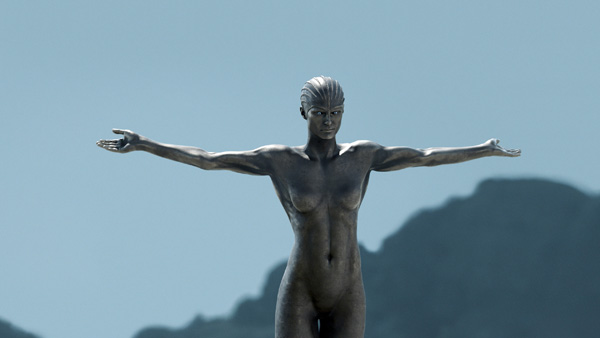
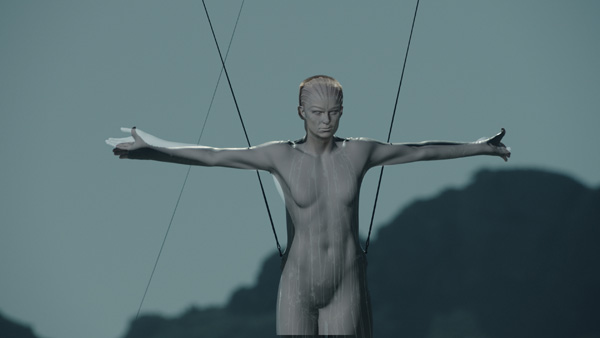
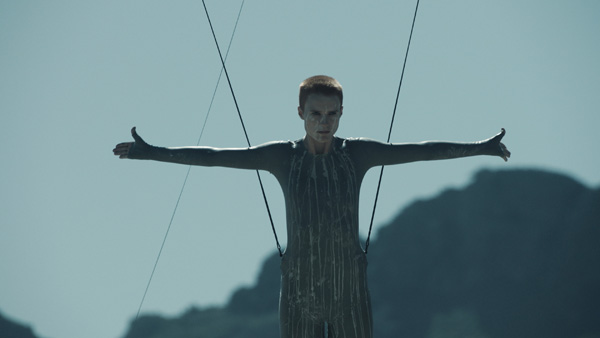
Since the Necromancer is extremely powerful and has more muscle than Mother, the artists had a job to make sure that their starting point was very close to her natural silhouette, and that their transformations were subtle and properly contoured around her body. The trick was that the Necromancer is an idealised, stronger form of Mother, with bigger shoulders and arms and a smaller waist, and is overall more sculpted, while the joints and pivot points remained the same.
Eric said, “After getting a basic sign-off on a turntable, we had to show off the model in shot context. A turntable and a real shot are two very different worlds. For example, getting the abdominal muscles right was critical – strong and defined, but not overly chiseled. This part of the sculpt had to balance with texture and lighting to work in a variety of environments. Slightly smaller muscles in the model, with slightly more patina in the recessed areas through texture and lookdev, was the path that got us to a final look.
“We did occasionally break away from the on-set, photographed lighting to better flatter the Necromancer with raking light. The patina, scratches and weathering were a challenge. What might look great in a wide would be too roughed up in a closeup. We ended up using a lot of mattes to fine tune the look per shot.”
Scream Attack

One of the most challenging sequences for MR. X was Mother’s attack on the Mithraic Ark, when she uses a deadly scream that tears apart everyone in her path. For the violent aftermath of this attack, the director had made his own concept sketch featuring a hallway full of tendrils of blood. To interpret this scene based on the set photography and Ridley’s sketch, MR. X first defined each element and how it should be approached.
The scream effect itself was created entirely in compositing, using distortions and glows to give the impression of sound waves blasting from Mother’s face toward her targets. As a response to her attack, the simulation of the blood tendrils needed to feel quite alien to the environment and even unaffected by gravity. The team was to show through this effect that the Necromancer’s powers are far beyond what humans are capable of.
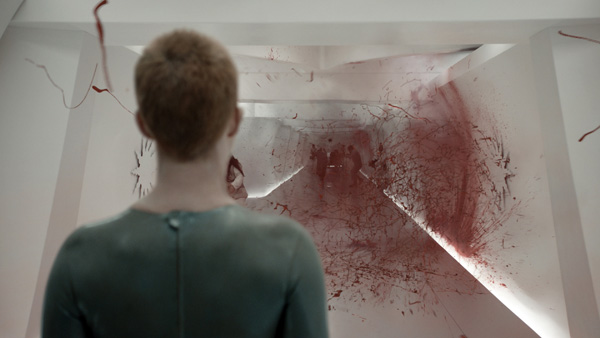
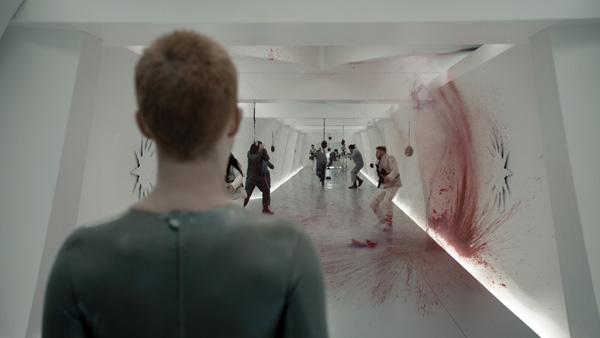
“Not purely a sound wave, our effect was heavily layered to build in visual complexity and show a clear, strong direction, with visual highlights that looked diamond-like. We used animated mattes to drive distortions, time-echo and time offsets to create duplicated ghostly images behind the scream,” said Eric
Blood Simulation
“So that the team would be able to use the plates to get the result Ridley wanted for the aftermath and tendrils of blood, the Ark Hallway attack required a lot of practical prep work on set. The amazing photography had special FX blood bags exploding on set, splashing the walls with blood and creating the stark red and white imagery. Where possible we rotoscoped and repositioned the victims to line up with the location of the blood bags, and the source of the tendril sphere. Special FX rigging needed to be painted out, and the aftermath blood on the walls needed some touch ups to preserve continuity.”
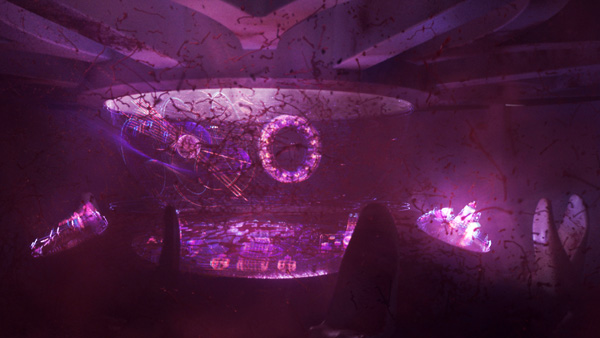
The blood tendrils were created as FX simulated in Houdini, rendered with Renderman and composited in Nuke. Giving them their zero gravity look was mostly driven by manipulating the Houdini simulations. “Once we had a final ‘pose’ for the blood tendrils we retimed the caches for a fast initial growth, and then a sudden speed change into slow motion,” he said. “Since the amount of layered detail didn’t allow for clean post-render retimes, we did this as early in the pipeline as possible. In addition to the tendril spheres we used simulated ambient blood tendrils, to float through the scene and maintain a visual dirtiness, which settled slowly over time.
Mirror
An effect the team used to visualise Mother’s destructive scream involved a mirror with its surface divided into hexagonal segments, a bit like mirrors inside large telescopes that use the design of a honeycomb. The result is Mother’s face broken up and repeated multiple times as she screams.
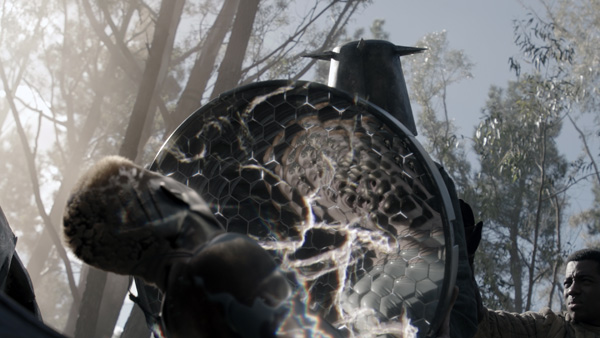
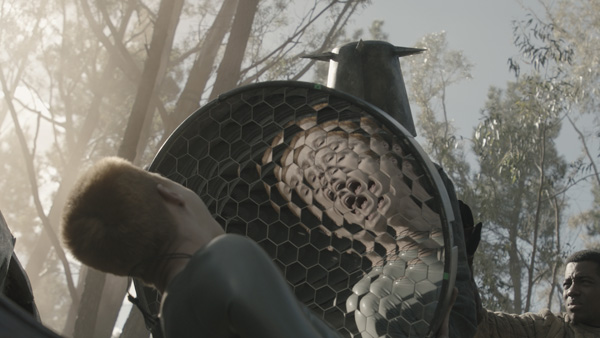
“This is my favourite scene in the series,” Eric said. “We match-moved Mother, giving us a full Necromancer layer to work with, and then used compositing mattes to design the amount of Mother vs Necromancer. The flexibility of keeping control of these mattes in the comp was very important because the amount of bronze skin was revised often throughout the scene. We also match-moved the mirror so that we could use that as projection geometry for the reflections of the Necromancer patches, as well as the animation added to the mirror and its edges.”
After the plates of Mother and the mirror were captured, distortion FX and glows were added to show a connection between the mirror, Mother and her power. Eric said, “We called the mirror electricity ‘dark energy’. This was another all-in-comp effect built in Nuke using Point Planes, Fractals and Noise with a lot of grading on top.
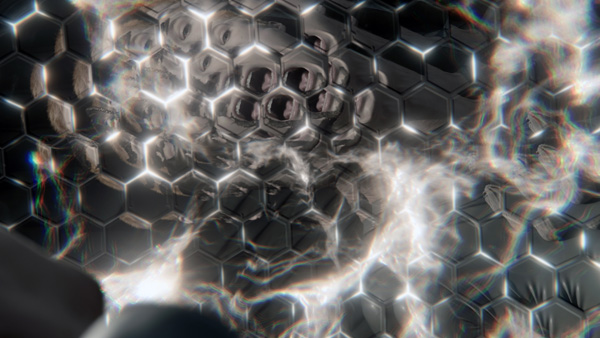
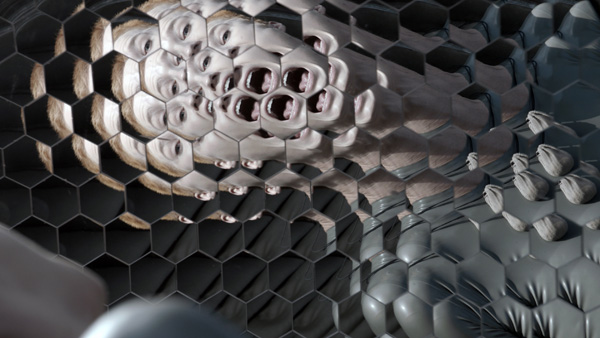
“Connecting Mother to the effects was an important part of the work. It was amazing what the team was able to achieve in getting the contouring around parts of Mother. It also gave the client a lot of freedom with art-directing where the tendrils went and when, for example. Kudos are due to the sound department as well, because their work on the scream really brought all of these elements together so well.” www.mrxfx.com
